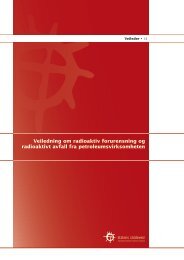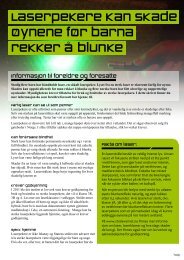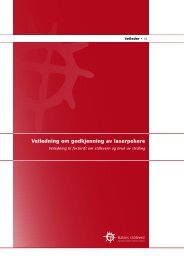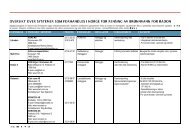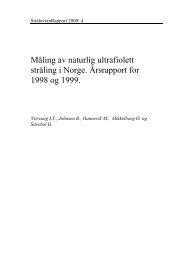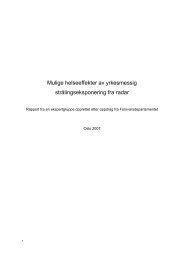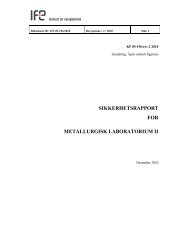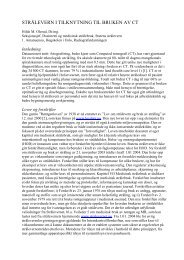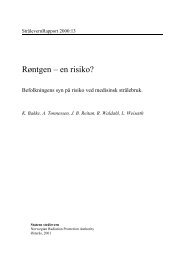Indoor Tanning in Norway - Statens strålevern
Indoor Tanning in Norway - Statens strålevern
Indoor Tanning in Norway - Statens strålevern
Create successful ePaper yourself
Turn your PDF publications into a flip-book with our unique Google optimized e-Paper software.
From this date all tann<strong>in</strong>g models needed an<br />
approval from NRPA before be<strong>in</strong>g sold, used<br />
or advertised <strong>in</strong> <strong>Norway</strong>. In addition to<br />
irradiance limits, the regulations <strong>in</strong>cluded<br />
requirements for user <strong>in</strong>structions and label<strong>in</strong>g.<br />
Approval was based on UV measurements<br />
from accepted laboratories and was valid for<br />
the tann<strong>in</strong>g device with specified sunlamps.<br />
2.1.1 Irradiance limits, 1983-1992<br />
From 1983 the UV irradiance limits were<br />
based on ACGIH-weighted UVC and UVB <strong>in</strong><br />
addition to spectral or unweighted UVA.<br />
Irradiances were <strong>in</strong>tegrated over the respective<br />
wave bands. The Norwegian and Swedish<br />
authorities agreed upon these limits be<strong>in</strong>g<br />
respectively around 4 and 2-2.5 times the UVA<br />
and ACGIH-weighted UVB <strong>in</strong> natural summer<br />
sun at 60°N. The new limits excluded the<br />
extremely UVC- and UVB-rich sunlamps, as<br />
well as extreme UVA-rich lamps, so <strong>in</strong>tens that<br />
sunburn easily could happen <strong>in</strong> only a few<br />
m<strong>in</strong>utes <strong>in</strong> case of a defective or misused<br />
timer.<br />
Sunbed irradiance limits <strong>in</strong> <strong>Norway</strong><br />
1983 - 1992<br />
UVC, ACGIH-weighted 0.002 W/m²<br />
UVB, ACGIH-weighted 0.05 W/m²<br />
UVA, unweighted 200 W/m²<br />
1993 -<br />
Short wave, CIE-weighted 0.15 W/m²<br />
Long wave, CIE-weighted 0.15 W/m²<br />
See Appendix C for explanation of weight<strong>in</strong>g<br />
functions and wavelength regions.<br />
2.1.2 Irradiance limits, 1993-<br />
In 1989 the European Committee for<br />
Electrotechnical Standardization (CENELEC)<br />
published harmonized European regulations<br />
based on an <strong>in</strong>ternational standard. <strong>Tann<strong>in</strong>g</strong><br />
models are classified <strong>in</strong>to UV types 1 to 4<br />
accord<strong>in</strong>g to the CIE-weighted UV irradiance<br />
(see Appendix C). Conflict<strong>in</strong>g national<br />
regulations had to be withdrawn with<strong>in</strong> a threeyear<br />
period (34-36).<br />
The Norwegian regulations were revised late<br />
1992 to implement the European Standard, EN<br />
60335-2-27. However, only UV type 3 tann<strong>in</strong>g<br />
devices were allowed for cosmetic purposes,<br />
i.e. with limited short and long wave UV<br />
irradiance. <strong>Tann<strong>in</strong>g</strong> models approved prior to<br />
the revision were still accepted <strong>in</strong> use. The<br />
European Standard also <strong>in</strong>cluded<br />
recommendations regard<strong>in</strong>g exposure times,<br />
i.e. the first exposure should not exceed a dose<br />
correspond<strong>in</strong>g to 100 J/m² and maximum<br />
yearly exposure should not exceed a dose of<br />
15 kJ/m².<br />
2.1.3 Convert<strong>in</strong>g 1983-1992 data<br />
To be able to compare the spectral irradiances<br />
from different time periods, all results are<br />
converted to CIE-weighted values based on<br />
conversion functions found from measur<strong>in</strong>g 69<br />
different fluorescent lamp types (10). Thus the<br />
1983-1992 limits is converted to 0.19 and 0.15<br />
W/m² CIE-weighted short and long wave<br />
irradiances, respectively. In other words, the<br />
limit for short wave irradiance was reduced<br />
from 0.19 to 0.15 W/m² <strong>in</strong> the autumn 1992.<br />
2.2 New regulations, 2004<br />
New regulations regard<strong>in</strong>g radiation protection<br />
and use of radiation <strong>in</strong> <strong>Norway</strong> took effect<br />
from 1 January 2004 (29). With respect to<br />
<strong>in</strong>door tann<strong>in</strong>g, there is still a restriction to UV<br />
type 3 tann<strong>in</strong>g models. Models approved<br />
accord<strong>in</strong>g to the previous regulations, but not<br />
classified as UV type 3, were only allowed for<br />
a two year transition period until 1 January<br />
2006. Regulations still <strong>in</strong>clude requirements<br />
for user <strong>in</strong>structions and label<strong>in</strong>g. The<br />
authority for <strong>in</strong>spect<strong>in</strong>g tann<strong>in</strong>g facilities and<br />
tann<strong>in</strong>g units is now delegated to local<br />
authorities.<br />
3 Approval of <strong>in</strong>door<br />
tann<strong>in</strong>g devices<br />
A total of 496 models of <strong>in</strong>door tann<strong>in</strong>g<br />
devices from 53 manufacturers were approved<br />
<strong>in</strong> 1983-2005. Irradiance data was available for<br />
all except 50 models where acceptances were<br />
based on Swedish approvals. The 446 models<br />
with available irradiance data <strong>in</strong>clude 41<br />
models approved with several lamp types and<br />
thereby different spectral output. All approvals<br />
are based on type test<strong>in</strong>g performed by<br />
11



